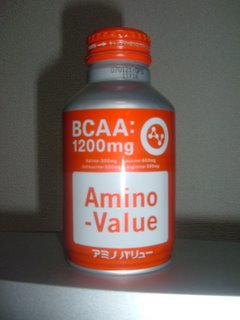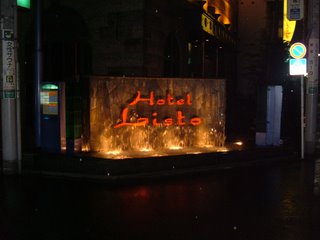Language stuff, and some random pictures
Monday I got up early, learned about polite verbs for three hours, and played pente. Pente is a distant relative of Go, where the objective is to get five of your pieces on the board in a row. But I doubt that you're here to read about Pente tactics; I learned it from a fellow Tar Heel, so there's not even the foreign aspect to make it interesting. So I'll take some time, if you don't mind, to touch on the basic language of Japan.
One of the benefits of being an isolationist island nation is that your way of writing can be as absolutely insane as you wish. Whereas most languages use one character system, and the crazy ones may use two, Japanese goes all-out with three almost completely different character sets:
1) Hiragana. The most common, probably the oldest. Composed of 46 characters, plus 23 more you can create by adding diacritical marks. (Fun fact for armchair linguists: These diacritical marks almost always turn an unvoiced consonant into a voiced! e.g. 'ta' (た)-> 'da' (だ)) Could theoretically be used to write every word native to the Japanese language, though some get a bit long. (Ex: 'yuubinkyoku' -> "ゆうびんきょうく" -> 'post office')
2) Katakana. The same number of characters--diacritical marks and all--but written completely differently. Used for writing words of foreign origin in the Japanese language. This includes English loanwords ('konpyuutaa' -> "コンピューター" -> computer') and English names ("rasu baraisu" -> "ラス バライス" -> 'your faithful author'). We're not the only source of origin, though; one of the primary examples of this is 'arubaito' ("アルバイト"), or 'part-time job', which comes from German, I think. Katakana is fun because once you learn the characters, you can read about 90% of the words you'll ever see written in it.
3) Kanji. Lifted more or less whole-cloth from the Chinese somewhere around the year 0, kanji are ideograms used in place of hiragana to construct various words. This starts to get tricky when kanji can be substituted for multiple sets of hiragana. For example, the "学" kanji, most commonly found in 'daigaku' -> "大学" -> 'college', 'gakusei' -> "学生" -> 'student', and the like, you'll also see it used in 'manabu' -> "学ぶ" -> 'to study' and who knows what else. The fact that a skilled Japanese speaker knows something upwards of the middle thousands of kanji makes this even more fun. Still, kanji are good for separating homophones. In speech, 'otera' (temple) and 'oterai' (bathroom) are one slurred vowel different, but in writing they show their stuff: "お寺" "御寺意".
There's also romanji, which is all three of the above languages phonetically spelled out in the Roman alphabet, but that doesn't really count. I'll probably be making some more points about how the Japanese language is a few Zigs short of a full base as I have time, so there's your quick crash course.
So there really aren't many chances to put pictures in there, so here's a few to compensate:

This looks like it should be on the store of a GNC somewhere, between the creatine and the Whizzinator, but it was in a vending machine so I drank it. Disappointingly, it was pretty much just another energy drink.
Posting is going to be scattered for the next few days, I'm afraid. I'll have short, pictureless updates Wednesday and Thursday, a full update Friday, and then nothing else until Tuesday. Read through the archives if you haven't done that yet, though. Trust me, there's plenty to go round.








1 Comments:
"I have to go wash the dishes, I'll call you back!"
Is that what they're calling it now?
Well, you go "wash the dishes" and then you give me a ring.
(Hey, it's not *my* fault I'm up so early that there's nothing left for me to do but scribble on your blog!)
(Actually, I think your blog is my most favoritest-est-est thing about Japan EVER! And you know, coming from me, that says A LOT!)
;-)
Post a Comment
<< Home